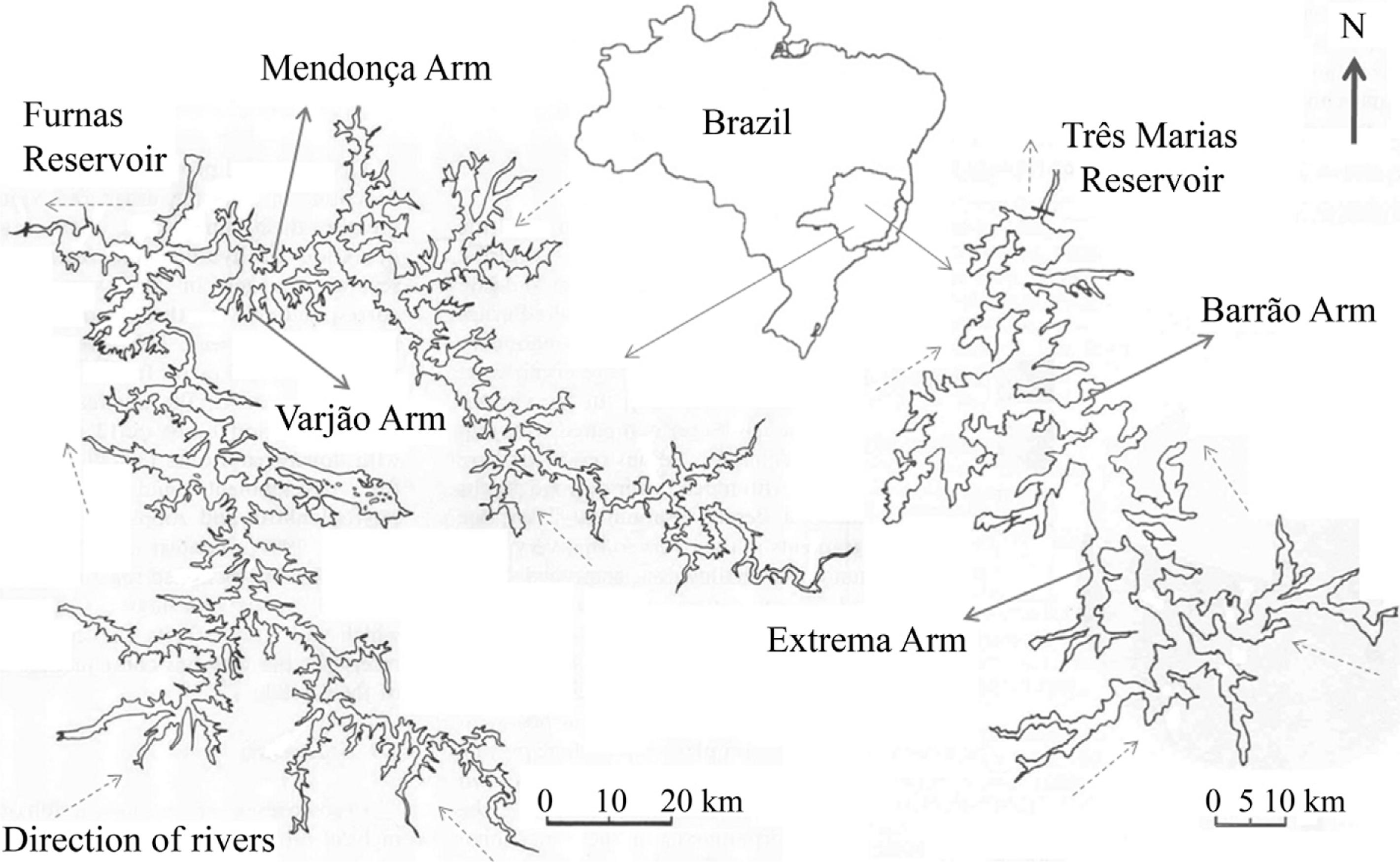| Reservoir or Lake |
Range (mg DW.m-3) |
Authors |
Trophic state* |
| Três Marias (MG) |
Cladocera: 0.43-4.00 |
this study |
|
| Copepoda: 1.50-15.39 |
|
|
| Furnas (MG) |
Cladocera: 1.19-7.59 |
this study |
|
| Copepoda: 1.43-16.07 |
|
|
| Segredo and Mourão (PR) |
Microcrustaceans: 0.03-20.26 |
Bletter & Bonecker, 2007 |
|
| Ponte Nova (SP) |
Cladocera: 9.264-9.794 |
Sendacz et al., 2006SENDACZ, S., CALEFFI, S. and SANTOS-SOARES, J., 2006. Zooplankton Biomass of
Reservoirs in Different Trophic Conditions in the State of São Paulo, Brazil. Brazilian
Journal of Biology, vol. 66, p. 337-350.
|
oligotrophic |
| Copepoda: 0.357-1.657 |
|
|
| Lagoa Dourada (SP) |
Cladocera: 3.496-10.037 |
Melão et al., 2005MELÃO, MG., ROCHA, O. and ROCHE, FK., 2005. Produtividade, Biomassa e
Flutuações Populacionais e interações biológicas da Comunidade
Planctônica e Suas Implicações na Transferência de Energia na Cadeia
Alimentar de um Reservatório Raso e oligotrófico. In ROCHE, FK. and ROCHA, O. (Eds.).
Ecologia Trófica de Peixes com ênfase na planctivoria em ambientes lênticos de
água doce no Brasil. São Carlos: Rima. p. 25-80.
|
|
| Copepoda: 0.852-5.956 |
|
|
| Dom Helvécio and Carioca (MG) |
Microcrustaceans: 26.57 and 10.88, respectively |
Matsumura -Tundisi & Tundisi, 1986 |
|
| Lago Batata (PA) |
natural station: 2.69-11.04 |
Maia-Barbosa, 2000MAIA-BARBOSA, PM., 2000. Ecologia de Cinco Espécies de Cladóceros de
um Lago Amazônico Impactado por Rejeito de Bauxita (Lago Batata, Pará-Brasil). Rio de
Janeiro: Universidade Federal do Rio de Janeiro. 218 p. Tese de Doutorado em
Ecologia.
|
|
| Lago Batata (PA) |
impacted station: 24.61-38.9 |
Maia-Barbosa, 2000MAIA-BARBOSA, PM., 2000. Ecologia de Cinco Espécies de Cladóceros de
um Lago Amazônico Impactado por Rejeito de Bauxita (Lago Batata, Pará-Brasil). Rio de
Janeiro: Universidade Federal do Rio de Janeiro. 218 p. Tese de Doutorado em
Ecologia.
|
|
| Broa (SP) |
Microcrustaceans: 10-15 peaks 60-80 |
Matsumura-Tundisi et al., 1989MATSUMURA-TUNDISI, T., RIETZLER, AC. and TUNDISI, JG., 1989. Biomass (dry weight and
carbon content) of plankton crustacea from Broa reservoir (São Carlos, SP, Brazil) and its
fluctuations across one year. Hydrobiologia, vol. 179, p. 229-236.
|
mesotrophic |
| Iraí (PR) |
Microcrustaceans: 7.14-261.52 |
Bletter & Bonecker, 2007 |
|
| Salto Grande (SP) |
Cladocera: 21.4-122.5 |
Rietzler et al., 2004RIETZLER, AC., ROCHA, O. and ESPINDOLA, ELG., 2004. Produção
Secundária de Espécies do Zooplâncton do Reservatório de Salto Grande,
Estado de São Paulo. In ESPINDOLA, ELG., LEITE, MA. and DORNFELD, CB. (Eds.).
Reservatório de Salto Grande (Americana-SP): caracterização, impactos e
propostas de manejo. São Carlos: Rima. p. 199-219.
|
|
| Copepoda: 117.0-319.0 |
|
|
| Guarapiranga (SP) |
Cladocera: 37.72-69.59 |
Sendacz et al., 2006SENDACZ, S., CALEFFI, S. and SANTOS-SOARES, J., 2006. Zooplankton Biomass of
Reservoirs in Different Trophic Conditions in the State of São Paulo, Brazil. Brazilian
Journal of Biology, vol. 66, p. 337-350.
|
|
| Copepoda: 6.48-236.18 |
|
eutrophic |
| Pampulha (MG) |
Cladocera: 40.42-572.16 |
Pinto-Coelho et al., 2005 |
|
| Copepoda: 11.34-379.51 |
|
|
| Barra Bonita (SP) |
Microcrustaceans: 50-100 |
Santos-Wisniewski et al., 2002SANTOS-WISNIEWSKI, MJ., MATSUMURA-TUNDISI, T. and ROCHA, O., 2002. Spatial and
Temporal Patterns of Zooplankton Biomass and Secondary Production in Barra Bonita Reservoir, Brazil.
In Proceedings of fourth International Conference on Reservoir Limnology and Water Quality. Ceske
Budejovice, TCH. p. 303-306.
|
|
| Amarela (MG) |
Microcrustaceans: 173.85 |
Matsumura -Tundisi & Tundisi, 1986 |
|
| Monjolinho (SP) |
Cladocera: 4 008 |
Okano, 1994OKANO, YW., 1994. Análise da estrutura e dinâmica populacional da
comunidade zooplanctônica de um reservatório artificial (reservatório
Monjolinho, São Carlos, SP). São Carlos: Universidade Federal de São Carlos.
128 p. Tese de Doutorado em Ecologia e Recursos Naturais.
|
|
| Copepoda: 2 560 |
|
|



